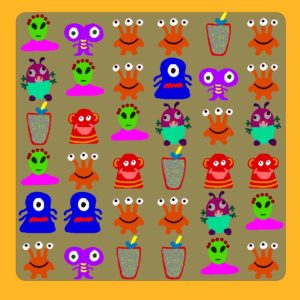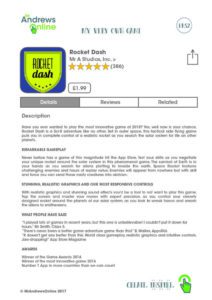

“Have you ever wanted to play the most innovative game of 2018? Yes? Well now is your chance. Rocket Dash is a Sci-Fi adventure like no other. Set in outer space, this tactical side flying game puts you in complete control of a realistic rocket as you search the solar system for life on other planets.”

Sounds fun? This review was written by two children in Year 4 who have taken part in the ‘My Very Own Game Project’.
As well as working in primary schools on a large number of cross curricular projects, Mr Andrews Online also includes three game design units that have always been a popular choice. Children from as young as 5 can design, make and edit games. The projects to choose from are:
Learning to design, build and program games can be an extremely rewarding experience for the children. Not only will they learn and understand how games work but they will also benefit from many other skills which will be useful in later life. Each of the gaming projects are designed to foster children’s skills in critical and creative thinking, problem solving, collaboration with their peers and can also be used a great stimulus to create some great multimedia content, writing and presentations.
When working in schools, a question I often ask is: “Does anyone have a device like this at home (holding up an iPad)?” Hands shoot up. “What do you do on these devices?” Nine time out of ten the answer is “play games!” This leads to a discussion about the type of games the children play and what makes them fun to play. The current most popular answers are Minecraft, Angry Birds, Crossy Roads, Candy Crush type games and Road Blocks.
Depending on the year group I might discuss with the children their experience of playing games. What makes a great game? What makes a game fun? Goals and objectives are key elements of some games whereas character and story might be important in other games. What are the differences between the games (e.g. puzzle, adventure or action).
With the class full of ideas, the children are put into pairs and asked to come up with their own game ideas. For younger children they might be provided with a theme, such as aliens or toys. In each of the projects the children create prototype characters, obstacles, enemies and power ups using digital drawing and design tools. Depending on the age of the pupils they can create a simple, advanced or expert game. Each stage progressively requires more skills in programming, logical thinking, planning, storytelling and graphic design.
Following the completion of their games there are numerous opportunities to further develop the pupils’ skills in learning and using multimedia tools for literacy. and presentations. Activities could include designing:
In conclusion using the game design unit as a teaching tool is an effective way to engage children in creative thinking. The children will further develop their critical thinking skills when they’re critiquing other games; collaborative skills when working in pairs; research skills if they’re choosing a particular topic; creativity skills in creating a game and problem solving skills in working out how to make a game more challenging. Game design projects are also a great way to introduce vital communication skills using a variety of multimedia tools to support spoken language, writing, and presentation skills.
